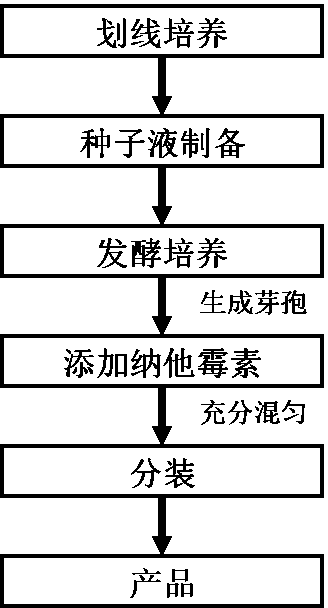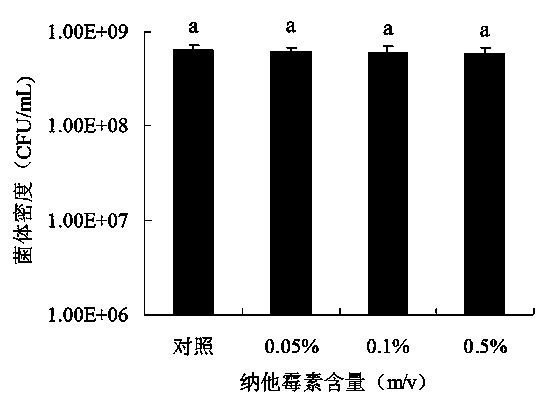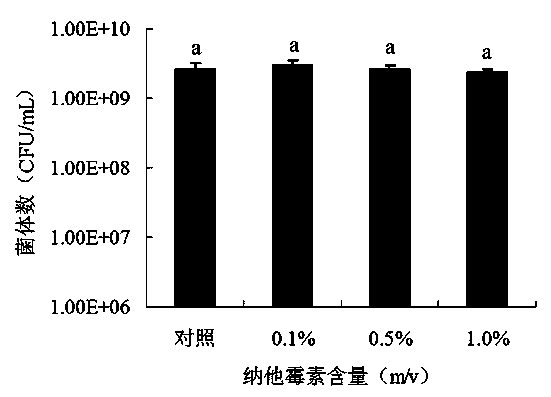Compound biological preservative and application method thereof
A technology of biological antiseptic and antistaling agent, which is applied in the direction of microorganism-based methods, biochemical equipment and methods, microorganisms, etc., and can solve the problem of the type and dose limitation of fungicides, excessive residues of pesticides and organic compounds, and the general effect of fruit and vegetable disease control, etc. problems, to achieve no pesticide residues, broad-spectrum antibacterial and disease prevention effects, and good compatibility
- Summary
- Abstract
- Description
- Claims
- Application Information
AI Technical Summary
Problems solved by technology
Method used
Image
Examples
Embodiment 1
[0032] Embodiment 1, the influence of natamycin on the growth of Bacillus amyloliquefaciens BGP20
[0033] 1) Preparation of seed liquid: take the glycerol-preserved bacterial strain of Bacillus amyloliquefaciens BGP20, inoculate it on a 2YT solid plate by streaking, activate and culture at 30°C for 36 h, and pick a single colony on a 25 mL 2YT liquid medium in a 100 mL Erlenmeyer flask, cultured for 36 h at a shaking frequency of 150 r / min, 30 °C, as a seed solution.
[0034] 2) Preparation of 2YT liquid medium containing natamycin: use sterilized water to prepare a mixed solution containing 5% natamycin as the mother solution, and sterilize at 85°C for 20 min. Add the sterilized natamycin stock solution into a 100 mL Erlenmeyer flask containing 25 mL of sterilized 2YT liquid medium, and the final concentrations of natamycin are 0.05% (m / v), 0.1% (m / v), 0.5% (m / v).
[0035] 3) Growth measurement: Inoculate the seed bacteria solution into 2YT medium with different natamycin...
Embodiment 2
[0037] Embodiment 2, the impact of natamycin on the germination rate of BGP20 spores
[0038] Transfer the BGP20 seed liquid to 2YT medium at a ratio of 1% (v / v), and culture at 30°C and 150 r / min for 72 h. Add natamycin to the liquid 2YT agar medium, the final concentrations of natamycin are 0.1% (m / L), 0.5% (m / L) and 1.0% (m / L) respectively, pour the plate for later use . The fermentation broth was placed in a water bath at 80°C for 20 min, diluted with sterilized distilled water, and spread on 2YT plates containing different concentrations of natamycin. 2YT agar plate without natamycin was used as control. Then culture them upside down at 30°C for 24 h, and investigate the number of colonies on each plate. Three plates were coated for each concentration gradient, and the same experiment was performed twice.
[0039] Such as image 3 As shown, it can be seen from the results that natamycin has no effect on the germination rate of BGP20 spores, even if the concentration ...
Embodiment 3
[0040] Embodiment 3, the impact of natamycin on the stability of BGP20 fermented liquid biocontrol agent
[0041] The BGP20 seed broth was transferred to the fermentation medium at a ratio of 1% (v / v), and cultured at 30°C and 150 r / min for 72 h. Natamycin was added to the BGP20 fermentation broth to make the final concentrations 0.1% (m / v) and 0.5% (m / v), respectively, and the BGP20 fermentation broth without natamycin was used as a control. The bacterial solutions of each treatment were stored at room temperature, and the number of viable bacteria in the cultured bacterial solutions of each treatment was investigated at 0 d, 30 d, and 60 d after treatment, and colony counts were carried out by using the method of gradient dilution plate coating. In addition, 3 sterilized test tubes were filled with each treated bacterial liquid, and each test tube was filled with 10 mL of bacterial liquid, left at room temperature, and the bacterial settlement was continuously observed, and ...
PUM
 Login to View More
Login to View More Abstract
Description
Claims
Application Information
 Login to View More
Login to View More - R&D
- Intellectual Property
- Life Sciences
- Materials
- Tech Scout
- Unparalleled Data Quality
- Higher Quality Content
- 60% Fewer Hallucinations
Browse by: Latest US Patents, China's latest patents, Technical Efficacy Thesaurus, Application Domain, Technology Topic, Popular Technical Reports.
© 2025 PatSnap. All rights reserved.Legal|Privacy policy|Modern Slavery Act Transparency Statement|Sitemap|About US| Contact US: help@patsnap.com



